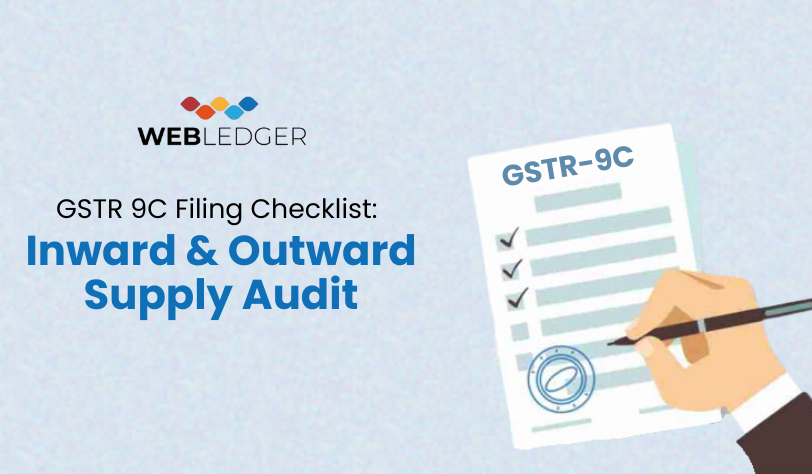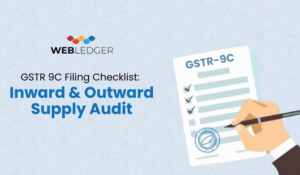GST compliance is an ongoing process, and one thing remains constant: filing the annual GST return is a critical responsibility for every business, big or small. To simplify this task, a structured GSTR 9C filing checklist helps ensure accurate reconciliation of all inward and outward supplies.
When the deadline to the FY 2024-25 filings is nearing, a watertight GST audit checklist 2025 is the key to protecting any professional against rushing to meet the deadline, reconciling in time, and paying a fine. Preparation in time is also beneficial in decreasing the audit stress and saving time.
When you are looking at stacks of invoices, purchase registers, e-way bills and you are at a loss of where to begin, this guide is applicable to you.
We will guide you through the basics:
- highlighting the GSTR 9C filing checklist
- procedures to follow in an inward and outward audit of supplies
- best practices in internal documentation
The prior preparation enhances self-belief and compliance preparedness.
Better Accounting
Please enter the OTP below to proceed.
The Reasons as to Why a GST Audit Checklist 2025 is Important
Form GSTR-9 Annual Return
- The annual return summarises everything you did during the year in relation to GST, all your sales invoices, all your ITC claims, all the tax you paid.
- However, the stakes are high: once GSTR-9 and its reconciliation statement (GSTR 9C) are submitted, then it is impossible to revise it.
- This is why the GST audit checklist 2025 is not paperwork but rather your active tool to:
- spot the mistakes
- be sure of the accuracy of the data
- plan the GST liability smarter
- The checklist instills compliance discipline and accountability among the finance teams.
GSTR – 9C Filing Checklist: The Guide to a Smooth Audit
Submission of GSTR-9C implies that you are balancing your books of accounts with those figures that are reported in your annual GST returns.
Here is the checklist to use in FY 2024-25:
- Confirm GST registration information of all GSTIN in order to avoid mismatch in filing.
- GSTR-1, GSTR-3B and GSTR-9 submissions are duly done, within time limits.
- Compare match turnover, tax paid and input tax credit between audited financials and GSTR-9 data in order to identify any differences.
- Assemble audited balance sheet and P&L statements as supplementary audit evidence.
- Reconcile any differences like unreported supplies or any difference in ITC claim.
- Ensure that all the tax payments are done within time and challenge the duly filled challans to prevent fines.
- Check compliance on e-way bills on transactions that require fulfilling, which protects compliance with transport regulation.
- The next step is to upload the supplementary documents and the offline GST version of the GSTR-9C JSON file in time on the GST portal to submit it successfully.
This checklist will minimize audit inquiries and possible show cause notices.
Inward and Outward Supplies Audit: Triple Checking the Flows
The issue of the reconciliation between inward supplies (your purchases) and outward supplies (your sales) is the core of the compliance with GST.
Inward Supplies Audit
- Gather the purchase register, GST-2A and GST-2B to complete the audit period and include all the ITC that is eligible.
- Compare GSTR-2A and 2B with your purchase invoices with the aim of confirming that ITC is eligible on all your suppliers and you are not making ineligible claims.
- Reclaims Reverse ineligible ITC and reclaims documents where discipline prevails.
- Tell the vendors when their returns affect your claims to ITC in time so that corrective action can be taken.
- Checks, adjustments of credit/debit notes are made in accurate balances.
- Make sure that GST that is paid under Reverse Charge Mechanism (RCM) is taken into account properly to avoid the cases of liability omission.
- Compare your GSTR-9 to income tax returns so as to have a closer financial accuracy of both statutory filings.
Outward Supplies Audit
- Get sales information of sales registers, GSTR-1 and GSTR-3B as well as comprehensive coverage of outward supplies.
- Compare GSTR-1 and 3B with your books in order to identify any discrepancies which can lead to audit.
- Properly divide the segment sales between the B2B, B2C, interstate and exports to meet the GST requirements to the letter.
- Check HSN code and GST rates so as to rectify any misclassification at the expense of incurring expensive fines.
- Make sure that the creation of e-invoices and its reporting are correct and complete according to the GST requirements.
- Right corrections of supplies which had been wrongly shown in the earlier returns prior to filing, with clean records.
Internal Documents Checklist: Organising Your House
Prior to filing under GST, the annual return, ensure the accuracy and completeness of each and every underlining document:
- Keep recent books of accounts — make sure that all purchase, sales and ITC registers are complete and free of errors.
- Balancing the bank statements and GST payments and receipts, and detecting any discrepancies at the earliest stage.
- Write off GST invoice, credit note and debit note in an orderly manner so that they can be easily retrieved and checked during the audit process.
- All the GST payment forms raised throughout the year should be collected and stored to prove remittances of taxes.
Having good records will provide confidence to the auditors and will ease the filing and certification process.
The Major Lessons to Annual Return Filing under GST
By using a strong audit checklist and adhering to a documented GSTR 9C filing checklist, it will be ensured that:
- Improved accuracy of data because both GSTR-9 and GSTR-9C are unable to be amended after they have been submitted there is no need to end up doing a lot of work.
- Lean process of inbound and outbound supply audit, which assists in preventing ITC and revenue leakage.
- Stress-free and penalty free annual filing of returns under GST each and every year and this improves reputation with the tax authorities.
Conclusion
By the year 2025 and even later, compliance with GST is not all about checking the boxes but preparing to empower oneself.
Being a business owner, accountant or GST practitioner, a detailed GST audit checklist 2025 is to be your guide of accuracy, compliance and tranquility. Detailed audits done on time will allow saving of costs and improved fiscal planning.
You have not begun your annual reconciliation yet and now is the time. Prepare your checklists, make your reconciliations on time and get your annual filing with GST to indicate the actual health of your business!




